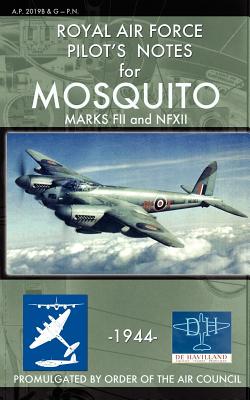Royal Air Force Pilot's Notes for Mosquito Marks FII and NFXII

Royal Air Force Pilot's Notes for Mosquito Marks FII and NFXII
When Britain's brilliant aircraft designer Geoffrey de Havilland first proposed the Mosquito, the Air Ministry greeted the idea with skepticism. Powered by twin Merlin engines, the bomber would be constructed almost entirely of wood and handle like a fighter. Stripped of heavy defensive weapons and armor, its advantage was its light weight and high speed, which would allow it to escape pursuing enemy aircraft. De Havilland's critics were silenced when the prototype flew in November of 1940. The plane quickly proved itself one of the fastest and most versatile military aircraft in existence, and production of the type commenced immediately. The "Wooden Wonder" (or "Mossie" as it was sometimes referred to) entered widespread service in 1942 and flew as a fast bomber, fighter-bomber, night fighter, path-finder, maritime strike aircraft, and fast photo-reconnaissance aircraft. The plane became particularly famous for set-piece attacks including a raid on Gestapo HQ in Oslo, an attack on a power station in Holland, and Amiens Prison. It also participated in the Normandy Campaign and D-Day. Created by the R.A.F., these notes were standard issue circa 1944. They contain fascinating information about aircraft operation, handling, and emergencies.
PRP: 80.29 Lei
Acesta este Prețul Recomandat de Producător. Prețul de vânzare al produsului este afișat mai jos.
72.26Lei
72.26Lei
80.29 LeiLivrare in 2-4 saptamani
Descrierea produsului
When Britain's brilliant aircraft designer Geoffrey de Havilland first proposed the Mosquito, the Air Ministry greeted the idea with skepticism. Powered by twin Merlin engines, the bomber would be constructed almost entirely of wood and handle like a fighter. Stripped of heavy defensive weapons and armor, its advantage was its light weight and high speed, which would allow it to escape pursuing enemy aircraft. De Havilland's critics were silenced when the prototype flew in November of 1940. The plane quickly proved itself one of the fastest and most versatile military aircraft in existence, and production of the type commenced immediately. The "Wooden Wonder" (or "Mossie" as it was sometimes referred to) entered widespread service in 1942 and flew as a fast bomber, fighter-bomber, night fighter, path-finder, maritime strike aircraft, and fast photo-reconnaissance aircraft. The plane became particularly famous for set-piece attacks including a raid on Gestapo HQ in Oslo, an attack on a power station in Holland, and Amiens Prison. It also participated in the Normandy Campaign and D-Day. Created by the R.A.F., these notes were standard issue circa 1944. They contain fascinating information about aircraft operation, handling, and emergencies.
Detaliile produsului









